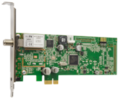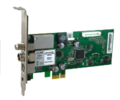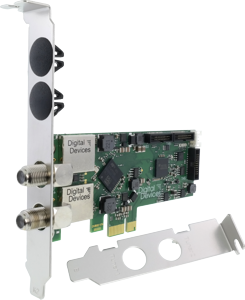DVB-S2 PCIe Cards: Difference between revisions
m (add unsupported card) |
|||
| (47 intermediate revisions by 14 users not shown) | |||
| Line 1: | Line 1: | ||
On this page you will find information regarding [[DVB-S2]] [[PCIe]] cards. |
On this page you will find information regarding [[DVB-S2]] [[PCIe]] cards. |
||
{{non-exhaustive list}} |
{{non-exhaustive list}} |
||
<br> |
<br> |
||
__TOC__ |
|||
| ⚫ | |||
==Firmwares== |
|||
... |
|||
Many of the devices on this page need a firmware, the best source for firmwares is [https://github.com/OpenELEC/dvb-firmware OpenELEC dvb-firmware repository]. |
|||
The firmwares on OpenELEC's repository are already extracted, just download the proper .fw file and copy to your firmware folder (usually /usr/lib/firmware). |
|||
| ⚫ | |||
The following tables list the known DVB-S2 PCIe devices and provides a brief summary of their features and components. (or at least it should) |
|||
If you need more technical information on a device, have a look at its device specific wiki article if there is one. |
|||
The device specific article is linked via the device's name but not all are linked yet. |
|||
If you find an article (e.g. via the search feature on the left) then please edit the device entry here add that link. |
|||
Just click on the edit icon in the last column of the device's row. |
|||
If you are unsure about how to do it, click on the edit icon for a device that already has a link to see how it is done. |
|||
Please feel free to create a device specific page if there is enough worthwhile information that doesn't fit in the comments field. |
|||
There is also a [[DVB-S2 PCIe Devices/Full|full detail table]]. |
|||
If you'd like to add a new device (supported or unsupported), please go to [[Template:PCI_Device_Data]] and follow the instruction there. |
|||
If a device is unsupported, please add with which OS/kernel version you tested last. |
|||
{{Device_List_Medium_Detail/Header |
|||
| content = |
|||
{{PCI_Device_Data |
|||
|renderwith=Device_List_Medium_Detail/Row |
|||
|selatt1=hostinterface |
|||
|selval1=PCIe |
|||
|selatt2=standard |
|||
|selval2=DVB-S2 |
|||
}} |
|||
}} |
|||
| Line 10: | Line 44: | ||
{{help to support}} |
{{help to support}} |
||
* Micronas reference design|| STB0899 + STB6100 + Micronas PCIe Bridge (Dual DVB-S2, PCIe, no CI) .... PCIe Bridge driver needs some more work |
|||
* NetUP Dual DVB S2 CI |
|||
=== Supported by 3rd Party Drivers === |
|||
| ⚫ | |||
{{3rd_party_drivers}} |
|||
| ⚫ | |||
| ⚫ | |||
| ⚫ | |||
Latest revision as of 17:22, 16 February 2014
On this page you will find information regarding DVB-S2 PCIe cards.
- The information contained here is likely non-exhaustive and, despite best efforts to do otherwise, may contain errors. (Please help to keep these lists up-to-date so that they are useful for everyone!)
- If your device is not listed, try:
- searching the existing mailing list archives:
- searching for information with Google or other internet search engine
- by posting a question about the device directly to the LMML (but please do conduct a search first, as it may already have been discussed!)
- Note: when it comes to support, it is generally a good idea to try the current V4L-DVB sources because some device drivers can be very new and thus may have not made their way into the mainstream kernel.
- In any regard, in respect to the above listed suggestions, you may find it to be the case that your device is actually already supported or that experimental support is available.
- Because the component constitution on many devices are often similar or identical, there may be devices that are unlisted but may actually work with the existing driver framework for previously supported devices. In such a case, your non-listed but working device will likely be reported in your system messages as being one of those previously supported devices. If you encounter such an occurrence, please do report your success on the LMML so that proper detection/identification of your device can be added within the drivers.
- Lastly, it bears worth repeating the request: Please help to keep these lists up-to-date so that they are useful for everyone!
Firmwares
Many of the devices on this page need a firmware, the best source for firmwares is OpenELEC dvb-firmware repository.
The firmwares on OpenELEC's repository are already extracted, just download the proper .fw file and copy to your firmware folder (usually /usr/lib/firmware).
DVB-S2 PCIe Devices
The following tables list the known DVB-S2 PCIe devices and provides a brief summary of their features and components. (or at least it should)
If you need more technical information on a device, have a look at its device specific wiki article if there is one.
The device specific article is linked via the device's name but not all are linked yet. If you find an article (e.g. via the search feature on the left) then please edit the device entry here add that link. Just click on the edit icon in the last column of the device's row.
If you are unsure about how to do it, click on the edit icon for a device that already has a link to see how it is done. Please feel free to create a device specific page if there is enough worthwhile information that doesn't fit in the comments field.
There is also a full detail table.
If you'd like to add a new device (supported or unsupported), please go to Template:PCI_Device_Data and follow the instruction there. If a device is unsupported, please add with which OS/kernel version you tested last.
| Vendor Device/Model |
Supported | ID on Interface |
Hardware | Firmware | Comment / Pictures | URL | E |
|---|---|---|---|---|---|---|---|
| Prof Revolution DVB-S2 8000 | ✔ Yes | PCIe | STB6100 / STV0903 / Conexant CX23885 | v4l-cx23885-enc.fw | |||
| Micronas Reference Design STB0899/STB6100 | ✘ No | PCIe | |||||
| DVBSky S850 | ✔ Yes, by vendor [1] | PCIe | Montage M88TS2020 / Montage M88DS3000 / Conexant CX23885 | dvb-fe-ds300x.fw | |||
| TBS Technologies TBS6980 | ✔ Yes, by vendor [2] | 6980:8888 PCIe | NXP/Conexant CX24132 CX24117 CX23885 | v4l-cx23885-avcore-01.fw dvb-fe-cx24117.fw | |||
| TBS Technologies TBS6981 | ✔ Yes, by vendor [3] | 6981:8888 PCIe | NXP/Conexant CX24132 CX24117 CX23885 | v4l-cx23885-avcore-01.fw dvb-fe-cx24117.fw | |||
| Hauppauge WinTV-Starburst | ✔ Yes, in kernel since 3.9 | 0070:c12a PCIe | Conexant CX23888 / NXP TDA10071 | dvb-fe-tda10071.fw | 
|
||
| Hauppauge WinTV-Starburst2 | ✔ Yes, in kernel since 4.18 | 0070:f02a PCIe | Conexant CX23888 / Montage M88RS6000 | dvb-demod-m88rs6000.fw | for kernel <4.18 configure WinTV-HVR-5525 [modprobe "options cx23885 card=52" works for openSUSE Leap 15.1 kernel 4.12.14] | http://www.hauppauge.de/site/support/support_faq.php?n=FAQ.Linux | |
| Hauppauge WinTV-HVR-5525 | ✔ Yes, in kernel since 4.1 | 0070:f038 PCIe | Conexant CX23888 / Montage M88RS6000 / SiLabs Si2168-B40 / SiLabs Si2157 | dvb-demod-m88rs6000.fw dvb-demod-si2168-b40-01.fw | 
|
||
| TBS Technologies TBS6905 | ✔ Yes, by vendor [4] | PCIe | http://www.tbsdtv.com/products/tbs6905-dvb-s2-quad-tuner-pcie-card.html | ||||
| TBS Technologies TBS6984 | ✔ Yes, by vendor [5] | 6984:0013 PCIe | NXP SAA7160 | ||||
| TBS Technologies TBS6985 | ✔ Yes, by vendor [6] | 6985:0001 PCIe | NXP SAA7160 | http://www.tbsdtv.com/products/tbs6985-dvb-s2-quad-tuner-pcie-card.html | |||
| TBS Technologies TBS6982 | ✔ Yes, by vendor [7] | 6982:0001 PCIe | NXP SAA7160 | Dual tuner DVB-S/S2. | http://www.tbsdtv.com/products/tbs6982-dvb-s2-dual-tuner-pcie-card.html | ||
| TBS Technologies TBS6991SE | ✔ Yes, by vendor [8] | PCIe | http://www.tbsdtv.com/products/tbs6991se-dvb-s2-dual-tuner-dual-ci-pcie-card.html | ||||
| DigitalDevices CineS2 DVB-S2 V7 Dual Tuner | ✔ Yes | 18c3:0720 PCIe | Lattice FPGA | 
|
DigitalDevices | ||
| Cerona Networks XpressVu DVB-S2 Dual Tuner | ✔ Yes | PCIe | |||||
| DVBWorld DVB-S2 PCIE2005 | ✔ Yes | PCIe | |||||
| Mystique SaTiX-S2 Dual | ✔ Yes | 18c3:0720 PCIe | |||||
| NetUP Dual Universal CI | ✔ Yes | 1b55:18f6 PCIe | NetUP PCIe bridge based on Altera FPGA | Supports DVB-S/S2/T/T2/C/C2 
|
http://www.netup.tv/en-EN/netup-universal-dual-dvb-ci | ||
| NetUP Dual DVB-S2-CI | ✔ Yes | 1b55:2a2c PCIe | |||||
| TeVii S470 | ✔ Yes | d470:9022 PCIe | cx23885 m88ts2020 m88ds3000 | dvb-fe-ds3000.fw | |||
| TeVii S471 | ✔ Yes, in kernel since 3.5 | d471:9022 PCIe | cx23885 m88ts2020 m88ds3002 | dvb-fe-ds3000.fw | |||
| TeVii S480 | ✔ Yes, in kernel since 2.6.39 | PCIe |
Currently Unsupported DVB-S2 PCIe cards:
However, please note that inquiries to the mailing list:
- Should NOT be treated as an order drop-off queue. You're soliciting help from volunteer developers who work on V4L-DVB matters in their spare time, and such work can be non-trivial (i.e. requiring even thousands of hours work). So being demanding is one sure route to being ignored. (Honestly, this point really shouldn't even need to be written, but you'd be surprised at the number of irrational individuals who write into the mailing list demanding this or that).
- May pass without garnering a response—a distinct byproduct of the fact that there are a limited number of developers, whom might be able to help, that are associated with the project. Often times, even if they wished to help, their energies are entirely tied up with other projects. In such cases, the best path might be to try to spearhead the driver development for your device yourself, or hire someone who can.
Supported by 3rd Party Drivers
Sometimes a manufacturer forks v4l-dvb all on their own and writes a driver for their device so they can claim Linux support.
In-Kernel 3rd party Drivers
Advantages:
- It's possible your device will work.. for the moment.
- If the manufacturer provides open source drivers with an acceptable license, volunteers could technically implement this code in the Linux kernel for true support. However.. :
Disadvantages:
- The quality of the code (if open, there are also cases where you just get a binary blob) too often just isn't good enough and there's still too much work to be done to make the device work. There was probably a reason the manufacturer didn't just send their patches to the linux-media mailinglist.
- Depending on what exactly the manufacturer did, you may have to reinstall the drivers every time your kernel is updated.
- When the manufacturer stops updating the drivers, the drivers will quickly refuse to install as newer kernels are released.
In case a manufacturer provides open source drivers the patches can be sent to the linux-media mailinglist Linux-Media Mailing List (LMML). Keep in mind however that if the license isn't compatible with the Linux kernel or the quality of the code isn't good enough, these will not become a part of the Linux kernel.
NOTE: As linux media drivers are character based, drivers can be also written using libfuse's character device in userspace example. If written that way, an out-of-kernel driver can be written, which fully integrates to udev without the disadvantage of closed source or incompatibility to other drivers. Such driver would rely on kernel fuse and character device in user space support as well as libfuse.
Closed source userspace drivers (Sundtek)
Advantages:
- Same driver works with different Linux versions
- No need to reinstall drivers when your kernel is updated.
- Drivers can be profiled easily and more accurately than in kernelspace.
- If the driver crashes, it won't crash the system or kernel, only the driver and applications using the driver will be affected. Userspace drivers can also be used when debugging drivers for USB host controllers, as the userspace driver can't crash the system, making debugging easier.
- If the manufacturer would stop to support the drivers, the userspace driver will still continue to work with newer Linux systems
Userspace drivers use a modern device infrastructure, Kernelspace drivers were available at a time when Linux did not support userspace drivers, Sundtek spent a substantial amount of work to make userspace drivers happen.
As a track record, most Linux distributions and many Settopboxes which were released since 2006 are supported, even open source drivers don't have such a high backward compatibility.
Disadvantages:
- You can't look into the sources. While this may be not a problem for end-users, in case of issues Sundtek provides a support forum.